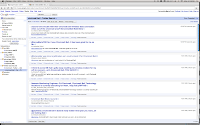
In this lab we have a number puzzle challenge that can be solved with a simple program. The lab works to give students a sense of the significance of round-off error and limited numeric precision.
Here is the puzzle: a music composer who would like to experiment with musical scales different from the traditional 12-note chromatic scale. This chromatic scale is essentially the notes derived from the series of eleven perfect fifths each with ratio 3:2 (or, equivalently think of a string fretted at length 2/3). This ratio series causes a peculiar tone issue, due to a round-off error sometimes called the Pythagorean Comma. This error in unavoidable since 2/3 raised to any power can not equal an octave, which must be an integral power of 1/2. The traditional 12-note scale produces a relative error in tone over 7 octaves of around 1.36%, as can be seen by the following calculation.
>>> (3.0/2.0)**12 / (2.0/1.0)**7
1.013643264770507812
The challenge is to find an alternative "chromatic scale" with more notes (derived by a longer series of perfect fifths) that produces less relative error over some number of octaves. Determine a method to systematically search for a) the precise number of notes in the scale and b) the precise number of octaves that will make the error smaller than the 1.3% c) finally, find the smallest such error possible (given restriction of double precision arithmetic.)












